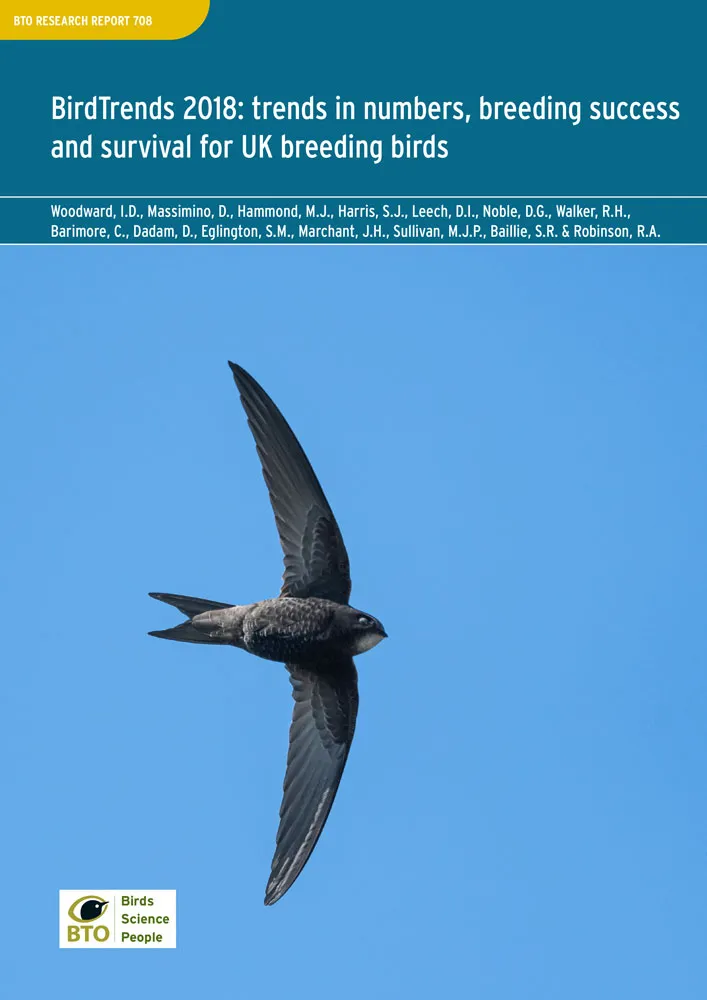BTO create and publish a variety of important articles, papers, journals and other publications, independently and with our partners, for organisations, government and the private sector. Some of our publications (books, guides and atlases) are also available to buy in our online shop.
Annual report of the Seabird Monitoring Programme
Seabird Population Trends and Causes of Change: 1986–2023
This report presents the latest seabird population trends in breeding abundance and productivity using data from the Seabird Monitoring Programme (SMP).
The report documents changes in the abundance and productivity of breeding seabird species in Britain and Ireland from 1986 to 2023, and provides a detailed account of the 2021, 2022 and 2023 breeding seasons.

Search settings
Investigating wader breeding productivity in the East Cairngorms Moorland Partnership Area using collaborative methods
Author: Jarrett D., Calladine J., Milner J., Wernham C., Wilson M.
Published: 2019
Breeding wader populations have declined significantly in recent decades in the UK. During this time, areas of moorland managed for grouse shooting and adjacent areas of rough pasture have been identified as persisting strongholds. A contributory cause to wader population declines is afforestation, and in the Cairngorms National Park (CNP) there is likely to be significant woodland expansion (with associated conservation gains for woodland biodiversity) in areas currently holding breeding waders. Land management planning in the CNP requires a balance between these and other competing objectives.
18.01.19
Reports
Exploring relationships between land use intensity, habitat heterogeneity and biodiversity to identify and monitor areas of High Nature Value farming
Author: Maskell L.C., Botham M., Henrys P., Jarvis S., Maxwell D., Robinson D.A., Rowland C.S., Siriwardena G., Smart S., Skates J., Tebbs E.J., Tordoff G.M.,Emmett B.A
Published: 2019
11.01.19
Papers
The Scottish Raptor Monitoring Scheme: recent developments in good practice monitoring
Author: Challis A., Edwards C., Heavisides A., Holling M., Kortland K., Mattingley W., Riddle G., Roos S., Stevenson A., Stirling-Aird P.K., Stroud D.A., Wernham C.V., Wilson M.W.
Published: 2019
The Scottish Raptor Monitoring Scheme (SRMS) has been operational for 15 years and provides many examples of how nationwide monitoring programmes for raptors and other scarce bird species could be developed.
06.01.19
Papers Bird Study
Declining population trends of European mountain birds
Author: Lehikoinen, A., Brotons, L., Calladine, J., Campedelli, T., Escandell, V., Flousek, J., Grueneberg, C., Haas, F., Harris, S.J., Herrando, S., Husby, M., Jiguet, F., Atle, J., Åke, K., Romain, L., Blas, L., Clara, M., Gianpiero, P., Thomas, C., Hans, S., Sirkiä, P.M., Teufelbauer, N. & Trautmann, S.
Published: 2019
Mountain areas often hold special species communities, and they are high on the list of conservation concern. Global warming and changes in human land use, such as grazing pressure and afforestation, have been suggested to be major threats for biodiversity in the mountain areas, affecting species abundance and causing distribution shifts towards mountaintops. Population shifts towards poles and mountaintops have been documented in several areas, indicating that climate change is one of the key drivers of species’ distribution changes. Despite the high conservation concern, relatively little is known about the population trends of species in mountain areas due to low accessibility and difficult working conditions. Thanks to the recent improvement of bird monitoring schemes around Europe, we can here report a first account of population trends of 44 bird species from four major European mountain regions: Fennoscandia, UK upland, south‐western (Iberia) and south‐central mountains (Alps), covering 12 countries. Overall, the mountain bird species declined significantly (-7%) during 2002–2014, which is similar to the declining rate in common birds in Europe during the same period. Mountain specialists showed a significant -10% decline in population numbers. The slope for mountain generalists was also negative, but not significantly so. The slopes of specialists and generalists did not differ from each other. Fennoscandian and Iberian populations were on average declining, while in United Kingdom and Alps, trends were nonsignificant. Temperature change or migratory behaviour was not significantly associated with regional population trends of species. Alpine habitats are highly vulnerable to climate change, and this is certainly one of the main drivers of mountain bird population trends. However, observed declines can also be partly linked with local land use practices. More efforts should be undertaken to identify the causes of decline and to increase conservation efforts for these populations.
04.01.19
Papers
BirdTrends 2018
Author: Woodward, I.D., Massimino, D., Hammond, M.J., Harris, S.J., Leech, D.I., Noble, D.G., Walker, R.H., Barimore, C., Dadam, D., Eglington, S.M., Marchant, J.H., Sullivan, M.J.P., Baillie, S.R. & Robinson, R.A.
Published: 2019
The BirdTrends 2018 report is a one-stop shop for authoritative information about the population status of the common breeding birds of the wider UK countryside. The report is based on data gathered by the many thousands of volunteers who contribute to BTO-led surveys.
01.01.19
Reports BirdTrends
